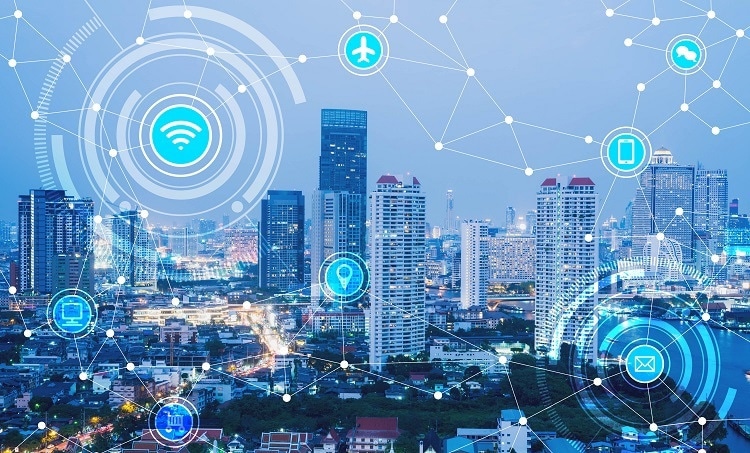
Image Credit:Shutterstock/VasinLee
Traffic lights that are in favor of buses and messaging drivers about congestion; smart parking system that adjusts parking cost based on occupancy rate; smart streetlights and sensors that monitor air quality and noise; sensors that can detect people smoking in non-smoking areas; network of sensors aimed to help the sick, elderly patients – these technologies are being used in London, San Francisco, Barcelona, Singapore and Oslo, respectively to improve quality of living in their cities and at the same time address sustainability. No wonder they are called “smart cities”.
Smart Cities
More than half of the world’s population lives in urban areas according to the United Nations Population Fund, and is expected to rise to 70% by 2050. This high population density poses challenges to cities especially in terms of waste management, energy consumption, allocation of resources, as well as other economic, environmental and health concerns. These concerns are being addressed and managed with the help of advanced and “smart” technologies giving rise to smart cities. British Standards Institute defines a smart city as the “effective integration of physical, digital and human systems in the built environment to deliver a sustainable, prosperous and inclusive future for its citizens”.
In the pursuit of cities to be more efficient and responsive, various kinds of electronic equipment such as cameras, sensors, smartphones and radio-frequency identification (RFID) devices are used. It is important that these devices are connected to be able to provide meaningful data which will be analyzed in order to come up with intelligent solutions for efficient urban systems such as transportation and energy systems.
Internet of Things (IoT) in Smart Cities
The Internet of Things brings those networks together. It gives the opportunity for devices to communicate not only within close silos but across different networking types and creates a much more connected world.
Caroline Gorski, Digital Catapult Head of IoT.
Smart cities deploy a large number of electronic devices that are interconnected and capable of providing information on its surroundings. Since connecting these devices via cables will be very expensive, the connection must be wireless. Monitoring must also be real time to eliminate scheduled actual inspections that will in turn reduce costs. IoT addresses these concerns, thus playing a big role in smart cities.
Below are some of the major IoT applications used by smart cities:
Public Transport and Traffic – several IoT technologies are being utilized to benefit both the government and the citizens in terms of making public transportation and traffic monitoring more efficient. The public can now monitor the arrival of the next train or bus through the GPS installed on the vehicles. Drivers, through the sensors placed in several parts of the roads, can also check which part/s is/are congested and plan an alternative route accordingly. Authorities, on the other hand, can use information from these devices to send officers in areas where they are needed, control traffic lights to alleviate traffic and plan other ways to improve road safety.
Environment Conditions – one of the goals of a smart city is to provide a healthier environment for its citizens. As such, networks of sensors are deployed across the city to monitor environmental conditions such as greenhouse gas emissions, carbon dioxide level, temperature and noise, among others. Data can be used to come up with solutions on how to reduce pollution and ensure that it is in the acceptable level.
Energy – IoT-enabled smart grids allow for more efficient power distribution and improved operations for energy companies. Data from smart meters, smart sensors and other connected devices can alert the company should there be power outages, for example, and address them immediately. The system can also provide information on customers’ energy consumption and allocate resources efficiently.
Healthcare – some of the use of IoT technologies in healthcare include locating of ambulances, checking of availability online of blood as well as organs for transplant, remote monitoring of patient’s health and tracking of available beds in a hospital, among others.
Challenges
While there are several benefits offered by IoT especially in terms of efficiency, productivity and sustainability, there are also challenges in implementing this system. Some of these challenges are lack of skills or technology to interpret the massive amount of data gathered from cities; risk of cyber-attacks or leakage of private and confidential information especially citizens’ data; and being limited by local regulations and policies, among others.
Sources
- The World’s 5 Smartest Cities: https://ioti.mobi/
- Albino, Vito & Berardi, Umberto & Dangelico, Rosa. (2015). Smart Cities: Definitions, Dimensions, Performance, and Initiatives. Journal of Urban Technology. 22. 2015. doi:10.1080/10630732.2014.942092. Available online: https://www.researchgate.net/publication/267038770_Smart_Cities_Definitions_Dimensions_Performance_and_Initiatives
- Smart cities: recent literature: http://www.theknowledgeexchange.co.uk/media/3050/Smart-Cities-recent-literature-briefing.pdf
- Talari, Shafie-khah, Siano, et. al. (2017). A Review of Smart Cities Based on the Internet of Things Concept. Energies. 10 (421). doi:10.3390/en10040421. Available online: http://www.mdpi.com/1996-1073/10/4/421/pdf
- Hancke, de Carvalho e Silva, and Hancke, Jr. (2012). The Role of Advanced Sensing in Smart Cities. Sensors. 13 (1). doi:10.3390/s130100393. Available online: http://www.mdpi.com/1424-8220/13/1/393/htm
- What is the Internet of Things? Wired Explains: https://www.wired.co.uk/article/internet-of-things-what-is-explained-iot
- The Urban Internet of Things: https://datasmart.ash.harvard.edu/news/article/the-urban-internet-of-things-727
Disclaimer: The views expressed here are those of the author expressed in their private capacity and do not necessarily represent the views of AZoM.com Limited T/A AZoNetwork the owner and operator of this website. This disclaimer forms part of the Terms and conditions of use of this website.